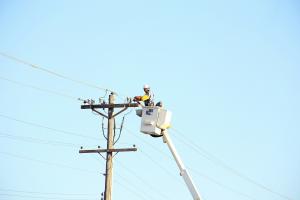
Eurelectric: six technologies to lower grid investments in Europe
The EU needs to invest €67bn in its power distribution per year. Grid technologies can help lower this figure by optimising assets and facilitating renewables.
Existing technologies can help face this complexity, optimise the existing grid, facilitate renewables integration and lower the overall investment bill according to Eurelectric’s report on Technologies supporting Grids for Speed.
“When reinforcing our grids, we must do it in a way that keeps system costs in check. Today we launch new tools to help policymakers control costs while increasing investments.”– said Eurelectric’s Secretary General Kristian Ruby.
Here are a few real-life examples:
ON LOAD TAP CHANGER TRANSFORMERS TO KEEP VOLTAGE LEVELS IN CHECK
Maintaining voltage levels in an adequate array is crucial to protect consumers equipment, but it’s not easy. Today voltage fluctuations are more common due to the variable wind and solar power generation as well as the more dynamic loads caused by EV charging. On Load Tap Changers (OLTC) can dynamically regulate voltage without having to switch off transformers, unlike manual tap changers.
During periods of high power supply and low demand, distribution system operators (DSOs) can tap the transformer down to maximise renewables’ integration allowing the voltage level to rise while staying within limit. During peak demand, on the contrary, DSOs can tap the transformer position up to maximise electric vehicle (EV) penetration, allowing the voltage level to decrease thus staying within limit. This becomes practically infeasible if carried out manually, considering how frequently this would happen, making OLTC indispensable.
Their installation and operation, however, require skilled resources, advanced monitoring and control systems. In addition, OLTCs must be coordinated with other smart devices and the remaining grid equipment to ensure an optimal system performance.
DYNAMIC LINE RATING TO MAXIMISE GRID CAPACITY IN REAL TIME WEATHER
The conductivity of an overhead distribution power line or underground cable varies in real time based on temperature, solar radiation, wind speed and direction. Weather conditions can affect the power lines’ temperature and how far down they hang, a characteristic known as sag. The lines cannot sag too much, as they risk touching vegetation and cause a power cut.
Traditionally, grid operators have not been able to quantify external conditions to determine a line’s capacity at each period of time. DSOs conventionally take extra precautions when determining a maximum capacity, making sure that lines are stable even in the worst-case scenario. Such approach is known as conservative or static line rating. Dynamic line rating (DLR), instead, can measure the maximum current a conductor can safely carry in real time, thus optimising grid capacity at any time.
This is possible thanks to sensors and control systems. For instance, on a cool, cloudy and windy day, more power can flow through an overhead line than on a hot, sunny and calm day. DLR not only reduces the risk of power cuts, but also mitigates grid congestion and contributes to security of supply. Their implementation however can be hampered by high upfront costs and lack of standardised regulation for its operation.
HIGH-TEMPERATURE LOW SAG CONDUCTORS TO INCREASE POWER LINE CAPACITY
High Temperature Low Sag (HTLS) conductors are conductors specifically engineered to handle higher operating temperatures with minimal sag compared to conventional ones. Traditional aluminium conductors tend to sag significantly under high temperatures limiting the amount of power that can be transmitted and posing safety risks. HTLS conductors, instead, are designed to operate efficiently at temperatures up to approximately 250°C, compared to the typical 90°C to 150°C range for conventional ones thanks to the use of advanced materials.
These technologies are tailored to specific situations. Their use will therefore depend on the issue, and topology at hand. To accelerate their deployment, Eurelectric identified four enablers:
1. POLICY: regulation should adopt a forward-looking approach that incentivises investments in in a neutral way. Existing disincentives such as investment caps and outdated remuneration structures should be urgently addressed, especially if using the technology increases operating expenditure (OPEX).
2. INNOVATIVE INVESTMENT STRATEGIES: new ways of working are necessary to support the implementation of these technologies. These include, for instance, anticipatory investments and higher flexibility. Some countries already started adopting these strategies as shown in Eurelectric's new DSO map.
3. COLLABORATION: partnerships among governments, regulators, system operators, market parties and customers are needed to drive innovation.
4. SKILLED WORKFORCE: workers capable of implementing and managing these advanced technologies are essential.
Last but not least: DIGITALISATION is the key pre-requisite for running these technologies. This includes digital systems to manage and control the grid, like Supervisory Control and Data Acquisition (SCADA) and Advanced Distribution Management Systems (ADMS). To provide these systems with accurate data, it's crucial to collect information using smart meters, sensors, and other remote control and metering devices. Additionally, a reliable and secure communication network is essential to ensure smooth data flow between devices, substations and control centers.
Eurelectric's new report was complemented by a new interactive DSO map to show EU countries' national infrastructure investment need, energy consumption and supply data. Take a look to see how national power grids are getting up to speed with the energy transition.
Note to Editors:
Eurelectric represents the interests of the European electricity industry. We seek to contribute to the competitiveness of our industry, provide effective representation in public affairs and promote the role of electricity in the advancement of society.
Eleonora Rinaldi
Eurelectric
+32 473 40 17 29
email us here
Visit us on social media:
X
LinkedIn
YouTube
Distribution channels: Building & Construction Industry, Energy Industry, Manufacturing, Media, Advertising & PR, Technology
Legal Disclaimer:
EIN Presswire provides this news content "as is" without warranty of any kind. We do not accept any responsibility or liability for the accuracy, content, images, videos, licenses, completeness, legality, or reliability of the information contained in this article. If you have any complaints or copyright issues related to this article, kindly contact the author above.
Submit your press release
